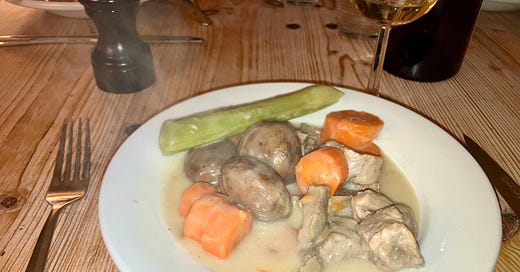Here in Paris, it’s freezing cold, and we’re shivering to the bone. The perfect occasion to revisit another classic of French culinary heritage: blanquette de veau.
No bright colors, no crispy crusts, no flamboyant sauces—blanquette de veau is a discreet, almost shy dish, with its pale sauce and tender pieces of meat. There’s something comforting in every bite, like a return to simpler things. Blanquette doesn’t aim to impress; it wraps you up. It doesn’t dazzle; it warms.
The history of blanquette dates back to the 18th century, when veal, prized for its tenderness, started being prepared "à la blanche" (in white) by the upper class. Back then, the meat wasn’t seared but gently poached in an aromatic broth. This slow, almost maternal cooking gives blanquette its melt-in-the-mouth texture and signature pale color. In French, the word blanquette itself evokes this milky whiteness, enhanced by the cream-thickened sauce.
Purists will tell you that bright orange carrots have no place in this monochrome picture, and that you should opt for old, white-colored varieties instead. As for sides, some swear by pilaf rice, others prefer steamed potatoes. That’s the trouble with culinary institutions in a country like France—everything tends to get museumified. In the end, there’s no right way to prepare this dish, just the way you prefer.
Here are a few tips to nail this winter dish, perfect for Sunday family meals and cozy dinners to lift your spirits.
#1
When preparing blanquette de veau, you generally want cuts that require slow cooking, like neck, shoulder, flank, breast, or brisket.
Purists insist you need at least two types of meat: a fatty cut (shoulder or neck) and a marbled one (brisket, flank, or breast).
Personally, I stick to shoulder—it has the perfect melt-in-the-mouth texture I love.
#2
Ask your butcher for some bones. Rich in collagen, they’ll add depth and texture to your broth.
#3
Stud one or two cloves into your onion.
#4
It’s essential to blanch the meat beforehand to make it more tender. Simply plunge it into cold water, bring it to a boil for just one minute, then rinse it before starting your blanquette.
#5
For tender meat, keep the water at a gentle simmer—never let it boil.
#6
Forty-five minutes of cooking is good, but an hour is better. Time is on your side.
#7
For perfect cooking, start by placing the meat in cold water with the onion and aromatic herbs. Bring to temperature until it reaches a gentle simmer, then maintain the heat. After that, add the carrots and let them simmer for 30 minutes, then the whole mushrooms caps for 20 minutes, and finally the leeks for 15 minutes.
#8
Never use canned mushrooms. It’s better with fresh button mushrooms.
#9
The sauce is better without egg yolk.
#10
The better your broth, the better your sauce. I always keep some broth at home—I use it for the sauce and save the broth from cooking the meat to sip on the next day.
#11
A key technique in cooking, a roux is made with equal parts butter and flour—that’s the simple secret. Use a saucepan, preferably with a thick bottom to avoid burning your roux. Cut the butter into pieces and melt it in the pan. It shouldn’t brown. When it starts to sizzle, take it off the heat and add the flour. Stir and return it to the stove. It will slowly thicken and release a pleasant, biscuit-like aroma.
#12
Crème fleurette (whipping cream) works particularly well for the sauce. I add it to the roux before incorporating the broth. My ratio: ⅓ cream to ⅔ broth.
#13
At every stage, never stop stirring your sauce.
#14
I believe white wine works better than red with blanquette. A Loire Valley Chenin, for example, is delicious. But a Savagnin from Jura… that’s pure bliss!
#15
In France, adding mustard to blanquette is considered sacrilege. Luckily for you, you don’t live in France (or you don’t care about traditions) and can get away with it—because it’s delicious (as long as you use whole-grain mustard and not the sweetened kind you find in some Anglo-Saxon countries).
#16
Like all slow-cooked dishes, blanquette is always better the next day!





